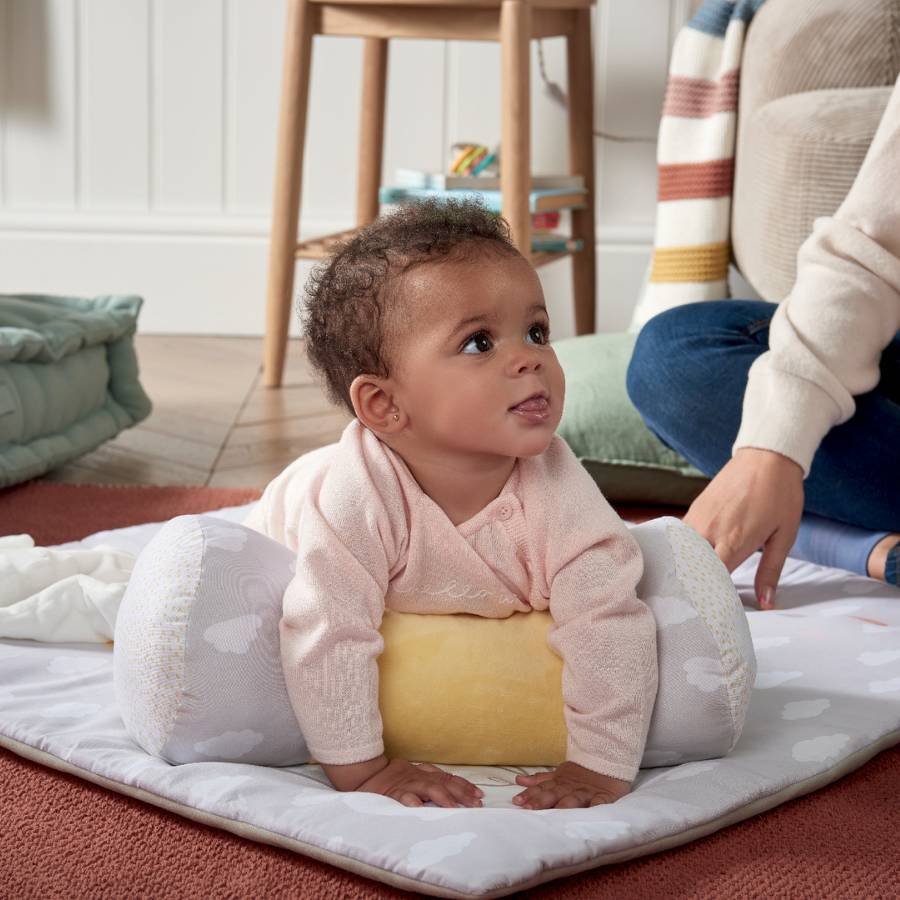
When to Start Tummy Time?
You can begin tummy time as early as your baby’s first week, once they’re settled at home. Initially, start with just a few minutes of tummy time while your baby is awake and supervised. Over time, gradually increase the duration as your baby becomes more comfortable on their belly.
For newborns, start by placing them on your chest for tummy time. As they grow, you can move them to a soft, flat surface like a playmat.
Benefits of Tummy Time
Tummy time offers a wide range of physical and developmental benefits:
- Strengthens Neck and Shoulder Muscles: It helps your baby develop the muscles they need for important milestones like rolling, sitting, and crawling.
- Prevents Flat Head Syndrome: By spending time on their tummy, your baby is less likely to develop flat spots on the back of their head.
- Enhances Motor Skills: Tummy time encourages your baby to practise movements that promote coordination and balance.
- Boosts Sensory Development: Lying on their tummy gives babies a new perspective, helping them learn more about their surroundings.

How to Make Tummy Time Fun?
Tummy time doesn’t have to be a chore! Here are a few ways to keep your baby entertained during this important activity:
- Engage with Toys: Place colourful, high-contrast toys within reach to encourage your baby to lift their head and engage their muscles.
- Join Them on the Floor: Your presence can be motivating. Lie down facing your baby and talk, sing, or make funny faces to grab their attention.
- Mirror Play: Babies love looking at themselves. Place an unbreakable mirror near their face to add an element of discovery.
- Change Scenery: Take tummy time outdoors or to different rooms. New environments can stimulate your baby’s curiosity.

Tummy Time Positions
There are several tummy time positions you can try as your baby grows and develops more strength:
- Tummy to Tummy: Lie on your back and place your baby on your chest. This is a great bonding position for newborns.
- Lap Time: Place your baby across your lap on their tummy while gently rubbing their back. This is ideal for younger babies who might not yet tolerate extended time on the floor.
- Floor Play: Place your baby on a flat, soft surface, such as a playmat or blanket. Encourage them to reach for toys or lift their head to look at you.
- Tummy with a Towel Roll: For extra support, place a rolled towel under your baby’s chest and arms. This helps elevate their upper body, making it easier to engage in tummy time.

Tummy Time by Age
The amount of tummy time your baby needs will increase as they grow. Here's a general guideline:
- 0–3 Months: Start with 3–5 minutes of tummy time, 2–3 times per day. Gradually increase as your baby becomes stronger.
- 3–6 Months: Aim for about 20–30 minutes of tummy time per day, broken into shorter sessions.
- 6+ Months: Your baby should be able to tolerate longer sessions. Aim for up to an hour of tummy time spread throughout the day.
Remember, every baby is different, so adjust the duration based on your baby’s comfort level.

Managing Crying During Tummy Time
It's common for babies to cry during tummy time, especially in the early stages. This is often because they find the position uncomfortable or challenging as their neck, arm, and back muscles are still developing. However, it's important not to avoid tummy time altogether, as it plays a vital role in building the strength needed for future milestones like rolling and crawling. To make the experience more enjoyable, try to keep sessions short and gradually increase the duration as your baby becomes more comfortable. Offering plenty of encouragement, using toys or mirrors for distraction, and staying close to comfort your baby can help reduce their frustration.




